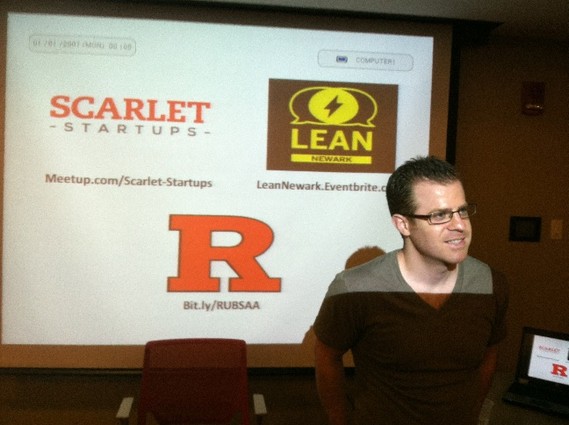The Speaker Who Actually Wrote the Book on VC Financing Rules

[Annett, a patent agent and entrepreneur, is president of Livingston-based Annett Enterprises.]
On June 27, 2013, Rutgers Business School Alumni Association (Newark), Scarlet Startups and Lean Startup Machine Newark jointly hosted a meeting of 35 registered attendees at which entrepreneurs were treated to an in-depth discussion on the realities of fundraising.
Members of the N.J. tech community got to listen to a speaker who figuratively wrote the book on VC financing and literally wrote a book on how to obtain it.
That speaker, Mark Peter Davis, not only lives and breathes startups but refers to himself as a “startup addict.” He is the founder of Interplay Ventures, a cofounder of Kohort, Venwise, DevSpark and Foundershield, a venture partner at High Peaks Venture Partners; and author of The Fundraising Rules.
Davis counted down the 10 most important issues that anyone seeking funding should know, continuing into negative numbers to share additional insights. Those issues and insights are as follows:
10. Is VC funding a Pandora’s box?
Too many entrepreneurs seek funding when they should be bootstrapping, and too many bootstrap when they should seek funding. Four situations in which companies can find themselves concerning the relationship between capital needs and scalability:
- If a company requires a high level of capital but has low scalability, the business is not viable.
- If a company has both low capitalization needs and low scalability, it should bootstrap.
- If a company has both high capitalization needs and high scalability, it should seek venture capital.
- The best situation for a company to be in: having low capital needs and high scalability.
- The fourth situation is often a stumbling point. Entrepreneurs must assess the barriers for competitors to beat them to scale. If the barriers to entry are high (for example, having strong intellectual property in place), a company should bootstrap. However, if the barriers to competitors are low, the company must scale as quickly as possible and should seek venture capital.
9. Debt vs. equity
Whether a company gets financed initially through equity-based financing or a convertible debt note — which defers decisions regarding equity until the subsequent round of financing — should be fairly easy to decide.
Said Davis, “If you have a good deal in place, lock it in. If you have [a bad] deal, wait for better days” [and take the convertible note].
8. Venture math
Business schools teach that valuation is determined by the equation pre-money value + investment = post-money value. That isn’t the way it actually works, however. Instead, VCs calculate almost in reverse, so the correct equation is investment/dilution → post-money valuation – investment = pre-money value.
For example, if a company is going to invest $5 million and owns 25 percent of the company, the post-money valuation is $20 million. If you subtract the investment of $5 million, the pre-money value becomes $15 million. However, the pre-money valuation doesn’t really exist until the investment and subsequent dilution is agreed on.
7. Three docs are needed.
- Only three documents are needed to obtain a VC funding deal:
- A one-page (at most) executive summary that lists just the key dimensions of the business.
- A 10- to 20-slide PowerPoint presentation explaining the business in broad brushstrokes.
- An operational model — a 60-column spreadsheet (one column for each month for the next five years) displaying income vs. usage and showing how the business will be built.
6. An investment overview slide is essential.
An investment overview slide should appear first in the PowerPoint presentation. While some patient VCs will allow entrepreneurs to tell their own story, most won’t. They want to know up front whether this deal is worth sitting through. If they don’t receive that information up front, they will be distracted and likely to interrupt the presentation.
5. Culture drives structure.
At this point, most venture deals are almost boilerplate. However, VCs’ culture is what determines which aspects are most important to them and what they emphasize. That said, everything is negotiable.
4. Fundraising is a lot like dating.
- Everyone has their own taste regarding whom they are interested in.
- Bigger is always better with regard to the market value for business.
- Everyone want to nab the hottie. People have a natural tendency to desire what they cannot get.
Nevertheless, there is a key difference between dating and VC funding relationships: in dating, partners may not share what they are up to with someone else, but VCs want to know what entrepreneurs are up to with other VCs, and progress should always be signaled to other VCs. For instance, if a startup is having a partners’ meeting with one VC or has received term sheets, the other VCs should be informed. Nothing will make them react faster than knowing that a company is a hottie and someone else is interested.
3. The two-step
It may be in an entrepreneur’s best interest to pursue both a convertible note and equity financing in the same round. Not needing the equity financing because of the convertible note may significantly improve the terms a startup is offered.
2. Raising money slowly
If a startup is offered term sheets by a VC and can raise money slowly, it may be able to tell the VC it is not currently reciprocating commitments. As entrepreneurs consider other VCs, they can let them know that they already have term sheets from another VC. This may even cause the initial VC to sweeten the deal.
No one in the VC community really knows what makes a good investment, and even the best VCs have only a 1:3 hit rate. As a result, they tend to gravitate toward what others have latched onto.
“Everybody wants to be the first to be second,” said Davis, and once you get that first term sheet, VCs may end up fighting for the chance to be the second ones to commit.
0. Expressions of love
While all the strategies above represent the traditional approach, “expressing your love” is the preferred strategy. That is, if a startup finds the right VC and they truly are the people they want to work with, it might be worth the risk of expressing that to the VC. If the feeling is mutual, just like in dating the startup and VC can quickly move on to a relationship that is both healthy and mutually beneficial.
A video of a similar presentation by the author is available here.

